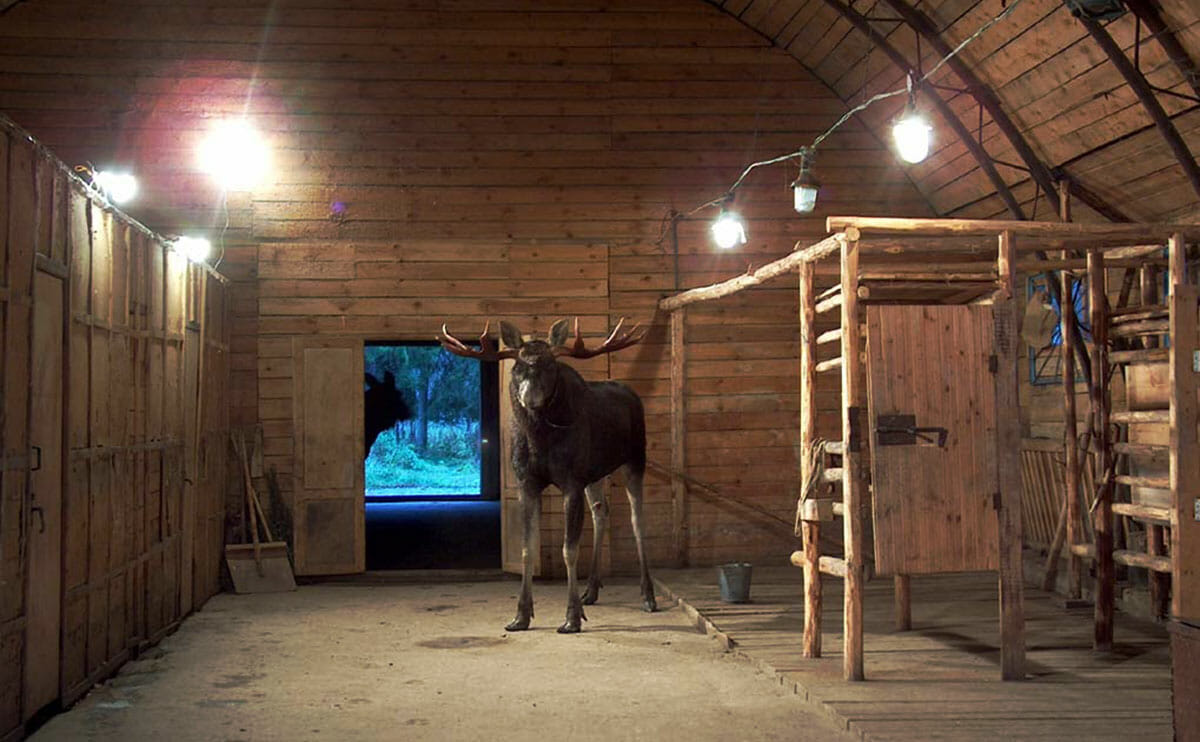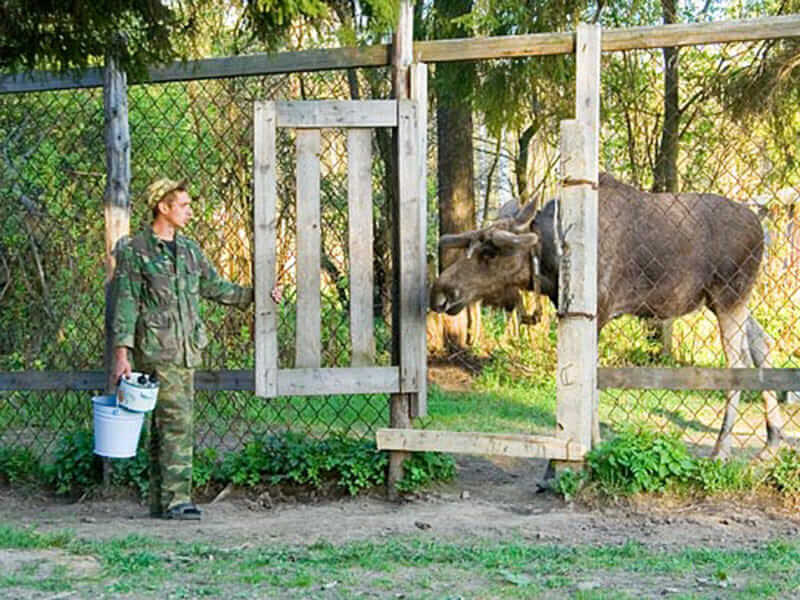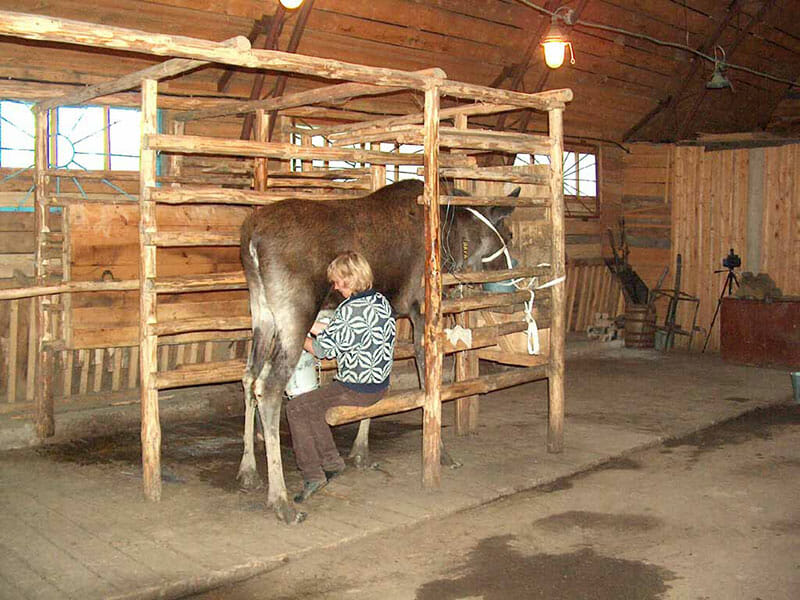Moose Milking in Russia
Moose milk. It’s a thing.

Carefully drawn from the teats of these northern giants, this pine-scented delicacy is renowned in the area as a cure for peptic ulcers. High in butterfat (usually coming in at around 10 percent, compared to cow milk’s average 5 percent), loaded with double the amount of essential amino acids as cow’s milk and chock-full of lypozyme – an enzyme that kills ulcer-creating bacteria – the slightly acidic milk has been used by Kostroma’s Ivan Susanin Sanatorium as a treatment for an array of diseases and disorders for over 30 years.
The sanatorium – an alternative therapy retreat for people suffering from gastrointestinal diseases – sources their entire milk supply from the nearby Sumarokovo Moose Farm. Originally established in 1966 and designed to house over 800 moose, the farm is now home to just under 30 animals.
This pine-scented delicacy is renowned in the area as a cure for peptic ulcers.
Alexander Minaev, a senior researcher at the Russian Academy of Sciences, oversees the government-owned farm and has studied the behavior of these semi-domesticated ungulates since 1978.
“I never worked much with cattle or horses, but working with moose is much more interesting because they are tame, free and wild all at the same time,” he says in an email interview.
Much like reindeer husbandry in Sweden, Norway and other northern countries, Minaev says the moose at Sumarokovo farm spend most of their time freely grazing in the forests surrounding the area. During calving season – late May to early June – Sumarokovo’s cows return to the farm (lured by the promise of tasty oats) to have their young. Minaev keeps track of their whereabouts daily using radio tags and GPS collars he designed.
Within a week of delivery, while the calves are busy frolicking with tourists, (at five days old they can already run faster than the average adult human) Sumarokovo’s dairymaids (yes, they are actually called dairymaids) begin harvesting the precious milk. On average, a female moose can produce between 1 and 6 liters of milk per day.

A cow cautiously returns to the farm.

Once a moose becomes comfortable with the dairymaids she will often allow bilateral milking.

Buckets of oats keep the moose still while in the milking stall.
Minaev says although the farm is “the most stable moose-milk provider for medication in Russia,” it is far from economically profitable. He says it remains open largely as a tourist attraction, something he is more than OK with.
“The moose farm is an ecological education center. It gives the unique opportunity of immediate intercommunication between people and these intelligent forest animals,” he says. “But it is also a center of conservation, it allows reproduction, resettlement and number restoration.”
Although moose is not likely to be the next chapter in the raw milk craze, intrepid dairy connoisseurs are welcome to visit the farm and try a glass of this rare beverage.
Photos courtesy of Alexander Minaev and the Sumarokovo Moose Farm
Follow us

This work is licensed under a Creative Commons Attribution-NoDerivatives 4.0 International License.
Want to republish a Modern Farmer story?
We are happy for Modern Farmer stories to be shared, and encourage you to republish our articles for your audience. When doing so, we ask that you follow these guidelines:
Please credit us and our writers
For the author byline, please use “Author Name, Modern Farmer.” At the top of our stories, if on the web, please include this text and link: “This story was originally published by Modern Farmer.”
Please make sure to include a link back to either our home page or the article URL.
At the bottom of the story, please include the following text:
“Modern Farmer is a nonprofit initiative dedicated to raising awareness and catalyzing action at the intersection of food, agriculture, and society. Read more at <link>Modern Farmer</link>.”
Use our widget
We’d like to be able to track our stories, so we ask that if you republish our content, you do so using our widget (located on the left hand side of the article). The HTML code has a built-in tracker that tells us the data and domain where the story was published, as well as view counts.
Check the image requirements
It’s your responsibility to confirm you're licensed to republish images in our articles. Some images, such as those from commercial providers, don't allow their images to be republished without permission or payment. Copyright terms are generally listed in the image caption and attribution. You are welcome to omit our images or substitute with your own. Charts and interactive graphics follow the same rules.
Don’t change too much. Or, ask us first.
Articles must be republished in their entirety. It’s okay to change references to time (“today” to “yesterday”) or location (“Iowa City, IA” to “here”). But please keep everything else the same.
If you feel strongly that a more material edit needs to be made, get in touch with us at [email protected]. We’re happy to discuss it with the original author, but we must have prior approval for changes before publication.
Special cases
Extracts. You may run the first few lines or paragraphs of the article and then say: “Read the full article at Modern Farmer” with a link back to the original article.
Quotes. You may quote authors provided you include a link back to the article URL.
Translations. These require writer approval. To inquire about translation of a Modern Farmer article, contact us at [email protected]
Signed consent / copyright release forms. These are not required, provided you are following these guidelines.
Print. Articles can be republished in print under these same rules, with the exception that you do not need to include the links.
Tag us
When sharing the story on social media, please tag us using the following: - Twitter (@ModFarm) - Facebook (@ModernFarmerMedia) - Instagram (@modfarm)
Use our content respectfully
Modern Farmer is a nonprofit and as such we share our content for free and in good faith in order to reach new audiences. Respectfully,
No selling ads against our stories. It’s okay to put our stories on pages with ads.
Don’t republish our material wholesale, or automatically; you need to select stories to be republished individually.
You have no rights to sell, license, syndicate, or otherwise represent yourself as the authorized owner of our material to any third parties. This means that you cannot actively publish or submit our work for syndication to third party platforms or apps like Apple News or Google News. We understand that publishers cannot fully control when certain third parties automatically summarize or crawl content from publishers’ own sites.
Keep in touch
We want to hear from you if you love Modern Farmer content, have a collaboration idea, or anything else to share. As a nonprofit outlet, we work in service of our community and are always open to comments, feedback, and ideas. Contact us at [email protected].by Tyler LeBlanc, Modern Farmer
April 30, 2014
Modern Farmer Weekly
Solutions Hub
Innovations, ideas and inspiration. Actionable solutions for a resilient food system.
ExploreExplore other topics
Share With Us
We want to hear from Modern Farmer readers who have thoughtful commentary, actionable solutions, or helpful ideas to share.
SubmitNecessary cookies are absolutely essential for the website to function properly. This category only includes cookies that ensures basic functionalities and security features of the website. These cookies do not store any personal information.
Any cookies that may not be particularly necessary for the website to function and are used specifically to collect user personal data via analytics, ads, other embedded contents are termed as non-necessary cookies.
ew
There is no such enzyme as Lypozyme. Its called Lysozyme
You know that’s no a female moose, it’s a male or bull moose. Talking about milking and photo is a male ???
Check your photo captions. Cow moose don’t have antlers.